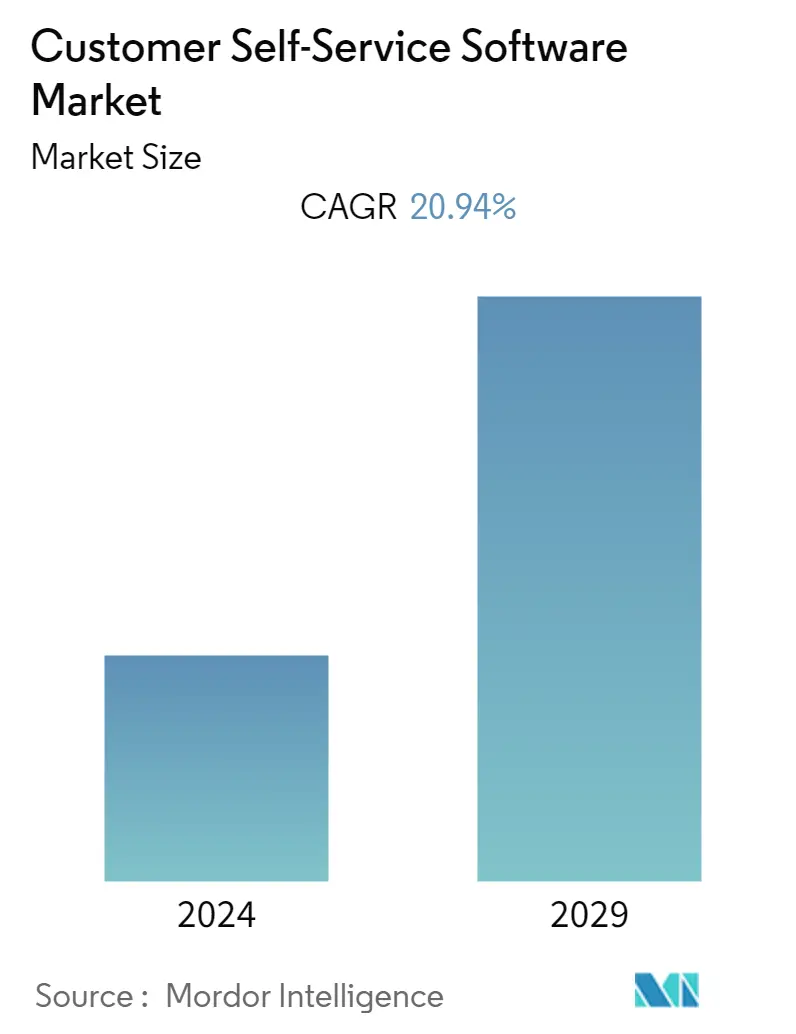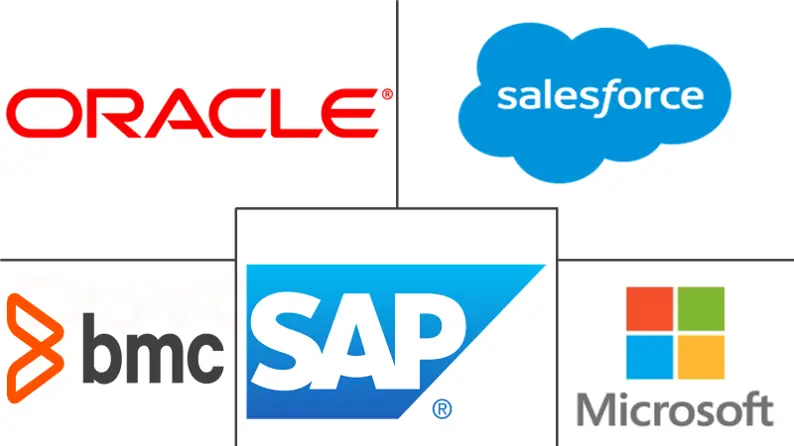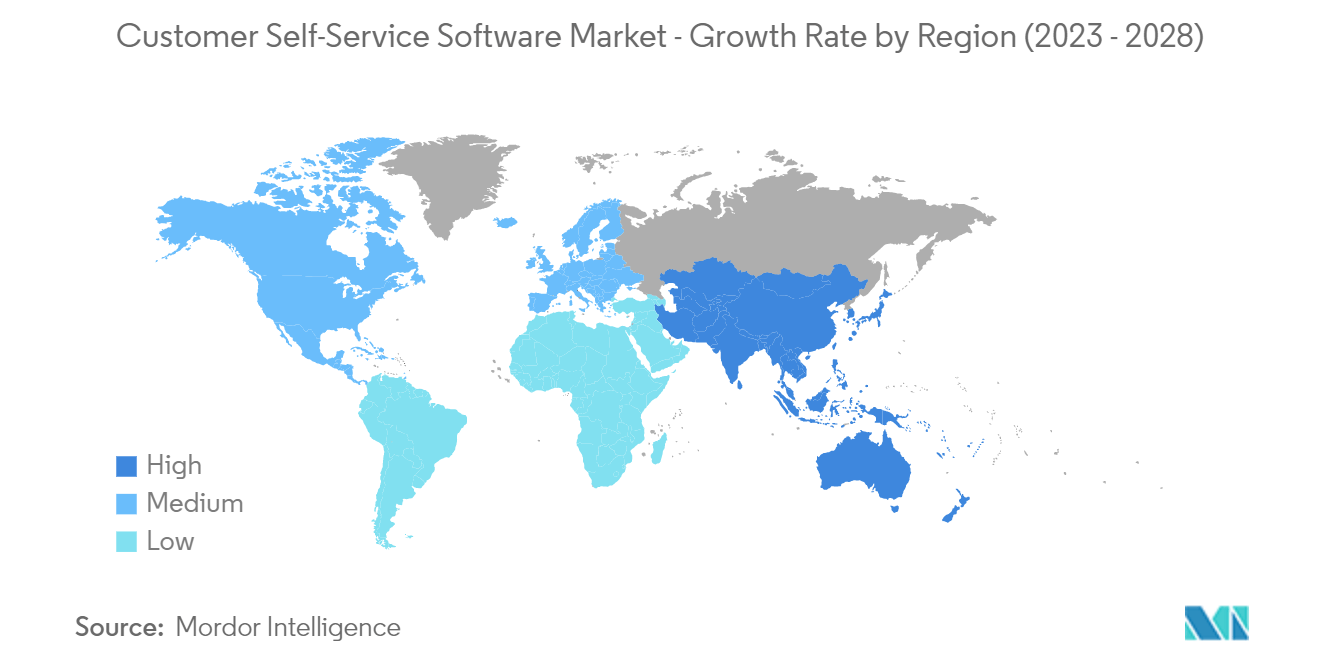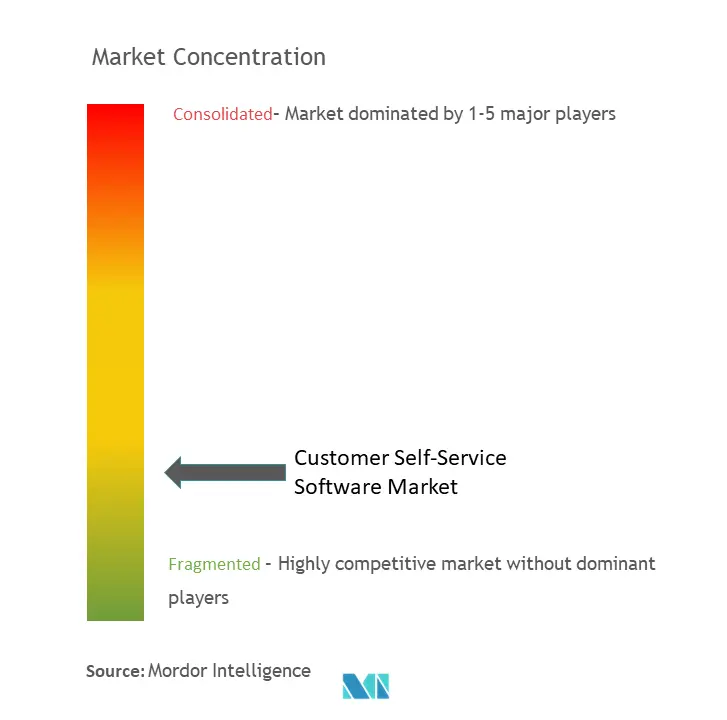Customer Self-Service Software Market Size

| Study Period | 2019 - 2029 |
| Base Year For Estimation | 2023 |
| CAGR | 20.94 % |
| Fastest Growing Market | Asia Pacific |
| Largest Market | North America |
| Market Concentration | Low |
Major Players
*Disclaimer: Major Players sorted in no particular order |
Customer Self-Service Software Market Analysis
The customer self-service software market is poised to register a CAGR of 20.94% during the forecast period. Organizations are increasingly implementing customer self-service software to expand their customer base and provide 24/7 help. Customer self-service software solutions allow businesses to respond efficiently to the ever-changing needs of their clients, increasing customer happiness and aiding in client retention. Customer self-service software can assist organizations in managing employee relationships and customer connections. As a result, businesses may be able to save the expenditures associated with purchasing separate software for managing employee and customer interactions. These are a few crucial elements anticipated to fuel market expansion for the foreseeable future.
- An increasing number of organizations now understand the benefits of reliable and dedicated self-service portals for enhancing the company's overall brand image. Self-service portals provide customers instant access to information, allow personalization, and save valuable time and organizational resources. According to SuperOffice, 70% of customers now expect a company's website to include a self-service application. The customized knowledge-based self-service portal plays a significant role in bringing in more website traffic. According to Salesforce, 39% of millennials check a company's FAQ when they have a question, showing a strong preference for finding answers.
- Some of the significant features of customer self-service software are it provides information to users without human interaction, assists end-users in completing familiar tasks, and provides continuous support to end-users seeking assistance. Most of the company helpdesks fail to deliver the required expectations, either due to being short-staffed or a lack of knowledge to answer a question immediately. Hence companies adopt these self-services, which help users find solutions themselves, often through a knowledge base or automated task management platform.
- The adoption of digital assistants is one of the significant trends emerging in the market. In the Retail and BFSI industry, chatbots have become a primary self-service feature. The companies utilize digital virtual assistants to enhance the customer experience. More companies are implementing AI- and ML-enabled chatbots and virtual assistants to leverage vital competitive advantages and improvise customer experiences. Further, chatbot technology is gaining much interest, with several companies investing significantly in Customer Relationship Management (CRM).
- However, it is projected that a potential lack of customer awareness and employee reluctance to implement self-service software will somewhat constrain market growth.
- The COVID-19 pandemic-related economic downturn led to a strategic shift in the purchasing criteria used by businesses, as they began putting business stability ahead of investing in new products and services. Before investing in self-service solutions, most companies think twice since any potential security holes in their third-party service providers' servers and information systems can jeopardize their clients' privacy. However, in the post-COVID-19 market scenario, owing to the benefits associated with customer self-service software, the demand for the software will increase throughout the forecast period.
Customer Self-Service Software Market Trends
This section covers the major market trends shaping the Customer Self-Service Software Market according to our research experts:
Increased Penetration of Cloud Services in the Retail sector is Expected to Drive the Market Growth
- The retail sector has been a significant adopter of customer self-service solutions for many years, and the trend is also expected to continue in the coming years. Retail companies are vying to deploy new technologies and are witnessing the growing adoption of self-service checkouts. Self-service has already made inroads in product-scanning technology, which retail majors are incorporating.
- According to Jumper.ai, chatbot technology isn't just a customer service tool for retailers, as it also can collect unique first-party customer data. The recent trend of AI in the sector is also developing space for technology. According to analytics firm Invoca, nearly half (49%) of US consumers trusted advice generated by AI technology in the retail category more than any other type analyzed.
- US-based Zappix offers cloud-based digital self-service solutions that leverage the speed of Visual IVR and the convenience of Robotic Process Automation (RPA) to provide enhanced customer experiences. Some of the claimed benefits of the solutions for retailers mentioned by the company are reduced calls to agents, lower contact center costs, enhanced customer experience, automation of repetitive processes, targeted revenue growth opportunities, enabling live agents to focus on high-value queries, and shorter average handling times per call, among others.
- Zappix also claims that its solution can be integrated with any CRM, Order Management System, and other back-end systems to connect customers directly to the retailer. The company also offers Zappix Actionable Analytics which tracks the customer journey and provides reports analyzing consumer behavior and trends. With other retail companies expected to follow suit, the demand for self-service solutions is poised to increase.
- As per a survey conducted by Flexera Software, in 2022, about 46% of respondents are running significant workloads on Amazon Web Services (AWS), and 45% are already running significant workloads on Azure. Thus, with the surge in the overall utilization of public cloud platform services running applications throughout the globe, the Customer Self-Service Software Market will witness an exponential growth rate during the predicted period.

North America Contributes to Maximum Market Share
- North America has the largest market share and dominates the customer self-service software market. This is due to the rising social media penetration, significant self-service software vendors, and high cloud-based deployment of self-service solutions. The increasing penetration of web self-service solutions and mobile among consumers is also estimated to encourage the growth of the North American market in the next few years. Additionally, the presence of several leading customer self-service software players is anticipated to supplement the development of the market studied.
- US-based Big Fish Games uses an automated SmartAssistant that leverages information from the customer's web session (including keywords searched) to offer a 360° personalized service. Using this approach, Big Fish Games has increased customer satisfaction to about 94%, achieved a self-service web rate of 96.4%, and saved USD 870,000. The recent COVID-19 outbreak further expanded the scope and adoption of customer self-service solutions in the retail industry. For instance, in its 22 Canadian stores, Walmart has deployed self-scanning outlets.
- Walgreen's Drugstore.com offers web self-service on Facebook and Twitter. Customers who search and shop online can chat with an agent to find products, resolve issues, and learn about promotions. With this strategy, the company has raised order sizes by 20% and saved around USD 350,000 through call deflection.
- Also, 7-Eleven Inc., an American international chain of convenience stores, offers a chatbot on Facebook Messenger to enhance the customer experience. The chatbot converses with the customers, using AI that powers automation, but also lets the users sign up for the 7Rewards customer loyalty program and find a nearby store with available discounts and promotions.
- Major regional companies have already embraced AI as a part of their digital transformation. For instance, banking service providers, like JP Morgan Chase, Bank of America, and Capital One, have already deployed virtual assistants in the form of chatbots. They have also successfully streamlined their back-end operations, such as workforce management, thereby saving high costs.

Customer Self-Service Software Industry Overview
The customer self-service software market is fragmented due to the rise in self-service, like ATMs, kiosks, and vending machines. The need for software is also increasing, which makes the market attractive for many companies to enter with their product offerings. Moreover, many players are offering solutions catering to the need of the consumers. Some key players in the market studied are Oracle Corporation, Salesforce.Com Inc., SAP SE, Microsoft Corporation, BMC Software Inc., and Verint Systems Inc., among others.
In December 2022, ThoughtSpot, the Modern Analytics Cloud company, and dbt Labs, a pioneer in analytics engineering, declared a formal partnership to bring self-service analytics to the modern data stack. The new alliance builds on the two companies' main work in recent months to create robust integrations that can provide tangible business value to shared customers such as Huel, Loan Market Group, TotallyMoney, Chick-fil-a, Roche, Nasdaq, and GoSharing.
In May 2022, Savant announced a technology partnership with Snowflake, the data cloud company, for self-service Analytics that allows joint customers to extract various key operational insights from Snowflake, without involving their BI and engineering teams. This partnership helps in the advancement of Savant's mission to make insights and data available to business leaders when and where they're needed.
Customer Self-Service Software Market Leaders
-
Oracle Corporation
-
Salesforce.Com Inc.
-
SAP SE
-
BMC Software Inc.
-
Microsoft Corporation
*Disclaimer: Major Players sorted in no particular order

Customer Self-Service Software Market News
- April 2022: Oracle announced the availability of its customer-managed analytics platform: - Oracle Analytics Server 2022. This is the next generation of Oracle Business Intelligence Enterprise Edition (OBIEE) and a great path to modernization for any individual needing to deploy analytics on-premises or customer-managed in the cloud via the Oracle Cloud Infrastructure Marketplace.
- April 2022: SAP SE announced that it had simplified its services and support portfolio by pivoting to focus heavily on customer adoption and consumption. The portfolio is primarily built for the cloud and designed to help customers realize value quickly and achieve lasting success.
Customer Self-Service Software Market Report - Table of Contents
1. INTRODUCTION
- 1.1 Study Assumptions and Market Definition
- 1.2 Scope of the Study
2. RESEARCH METHODOLOGY
3. EXECUTIVE SUMMARY
4. MARKET INSIGHTS
- 4.1 Market Overview
- 4.2 Industry Value Chain Analysis
-
4.3 Industry Attractiveness - Porter's Five Forces Analysis
- 4.3.1 Bargaining Power of Suppliers
- 4.3.2 Bargaining Power of Consumers
- 4.3.3 Threat of New Entrants
- 4.3.4 Threat of Substitute Products
- 4.3.5 Intensity of Competitive Rivalry
- 4.4 Assessment of the COVID-19 Impact on the Industry
5. MARKET DYNAMICS
-
5.1 Market Drivers
- 5.1.1 Increased Penetration of Cloud Services
- 5.1.2 Growing Demand for Network Security and Privacy
-
5.2 Market Restraints
- 5.2.1 Evolving Market Regulations
6. MARKET SEGMENTATION
-
6.1 By Deployment
- 6.1.1 Cloud
- 6.1.2 On-premise
-
6.2 By Offering
- 6.2.1 Solution
- 6.2.1.1 Web-based
- 6.2.1.2 Mobile-based
- 6.2.2 Service
-
6.3 By End-User Industry
- 6.3.1 BFSI
- 6.3.2 Healthcare
- 6.3.3 Retail
- 6.3.4 Government
- 6.3.5 IT and Telecommunication
- 6.3.6 Other End-user Industries
-
6.4 Geography
- 6.4.1 North America
- 6.4.2 Europe
- 6.4.3 Asia-Pacific
- 6.4.4 Latin America
- 6.4.5 Middle East & Africa
7. COMPETITIVE LANDSCAPE
-
7.1 Company Profiles
- 7.1.1 Oracle Corporation
- 7.1.2 Salesforce.Com Inc.
- 7.1.3 SAP SE
- 7.1.4 Nuance Communications Inc.
- 7.1.5 BMC Software Inc.
- 7.1.6 Microsoft Corporation
- 7.1.7 Verint Systems Inc.
- 7.1.8 Zappix Inc
- 7.1.9 Zendesk Inc
- 7.1.10 Zoho Corporation Pvt. Ltd
- *List Not Exhaustive
8. INVESTMENT ANALYSIS
9. FUTURE OF THE MARKET
** Subject To AvailablityCustomer Self-Service Software Industry Segmentation
Customer self-service (CSS) software enables users to secure answers to their inquiries, through an automated interview, instead of traditional search approaches. The software also allows companies to address customer support needs in an on-demand fashion. Self-service solutions have evolved into a user-centric platform approach, which enables an anywhere-anytime access model with data integration from multiple sources supported through an open architecture. The scope of the market studied covers the solutions and services offered by various vendors in the market.
The Customer Self-service Software Market is segmented by Deployment (On-premise and Cloud), Offering (Solution and Service), End-User Industry (BFSI, Healthcare, Retail, Government, IT and Telecommunication), and Geography (North America, Europe, Asia-Pacific, Latin America, Middle East & Africa). The market sizes and forecasts are provided in terms of value (USD million) for all the above segments.
| By Deployment | Cloud | |
| On-premise | ||
| By Offering | Solution | Web-based |
| Mobile-based | ||
| By Offering | Service | |
| By End-User Industry | BFSI | |
| Healthcare | ||
| Retail | ||
| Government | ||
| IT and Telecommunication | ||
| Other End-user Industries | ||
| Geography | North America | |
| Europe | ||
| Asia-Pacific | ||
| Latin America | ||
| Middle East & Africa |
Customer Self-Service Software Market Research FAQs
What is the current Customer Self-Service Software Market size?
The Customer Self-Service Software Market is projected to register a CAGR of 20.94% during the forecast period (2024-2029)
Who are the key players in Customer Self-Service Software Market?
Oracle Corporation, Salesforce.Com Inc., SAP SE, BMC Software Inc. and Microsoft Corporation are the major companies operating in the Customer Self-Service Software Market.
Which is the fastest growing region in Customer Self-Service Software Market?
Asia Pacific is estimated to grow at the highest CAGR over the forecast period (2024-2029).
Which region has the biggest share in Customer Self-Service Software Market?
In 2024, the North America accounts for the largest market share in Customer Self-Service Software Market.
What years does this Customer Self-Service Software Market cover?
The report covers the Customer Self-Service Software Market historical market size for years: 2019, 2020, 2021, 2022 and 2023. The report also forecasts the Customer Self-Service Software Market size for years: 2024, 2025, 2026, 2027, 2028 and 2029.
Customer Self-Service Software Industry Report
Statistics for the 2024 Customer Self-Service Software market share, size and revenue growth rate, created by Mordor Intelligence™ Industry Reports. Customer Self-Service Software analysis includes a market forecast outlook 2029 and historical overview. Get a sample of this industry analysis as a free report PDF download.



